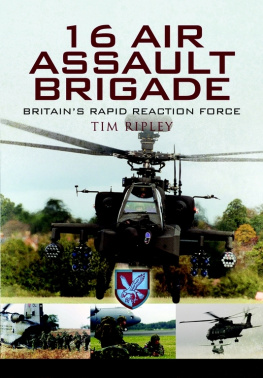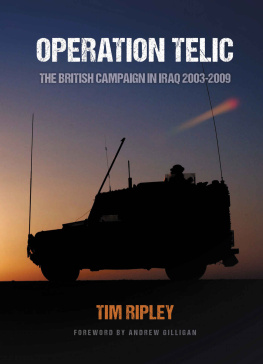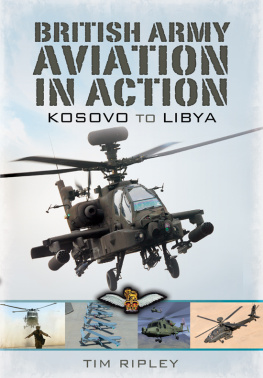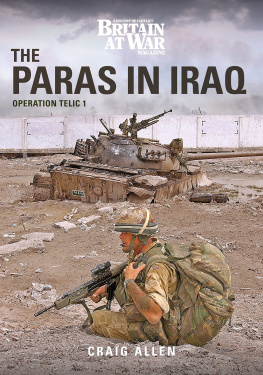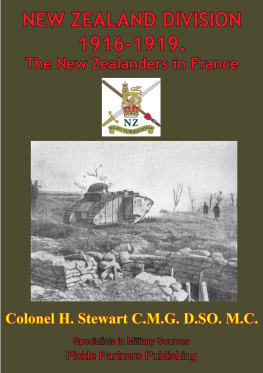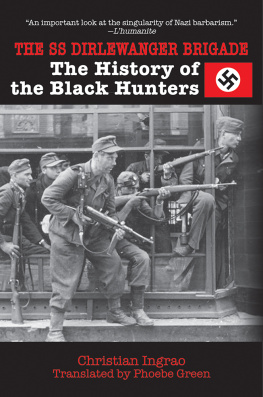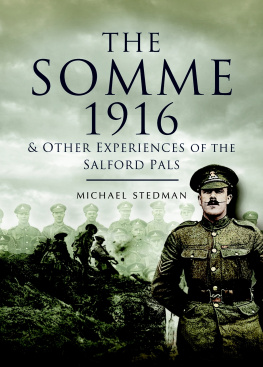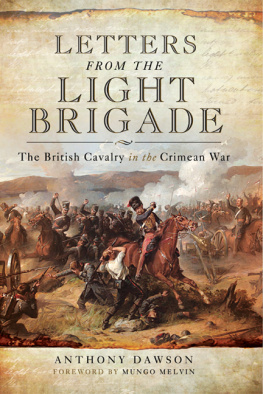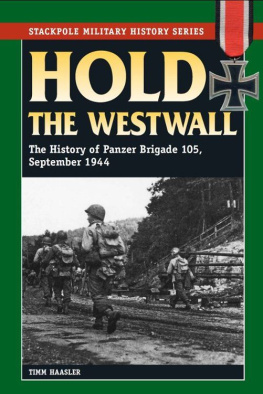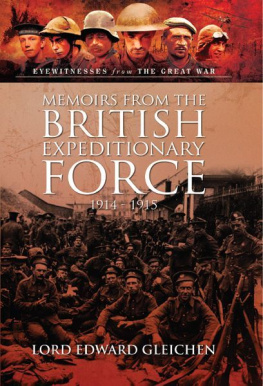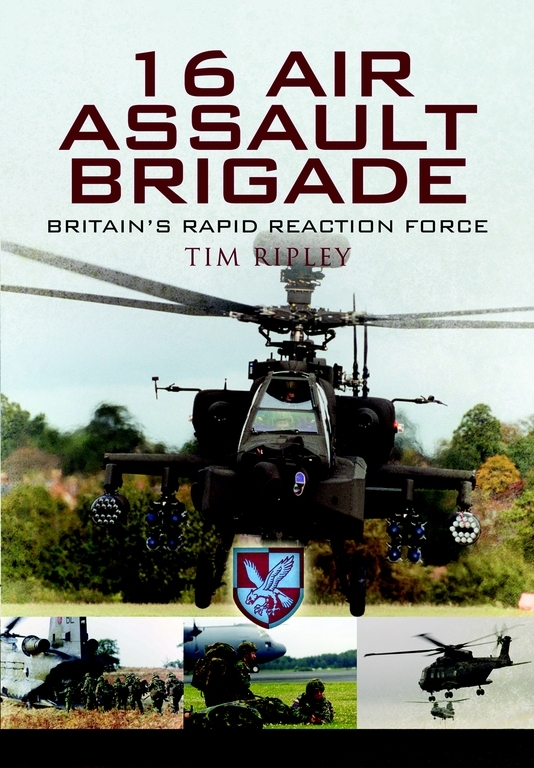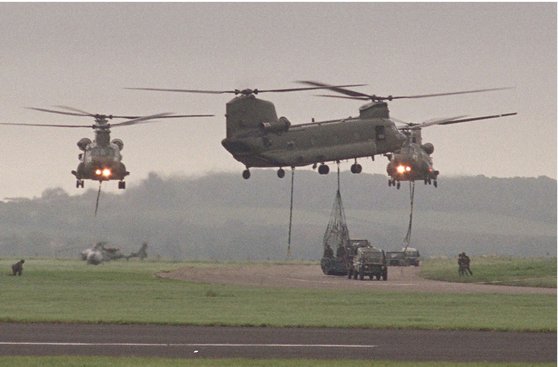Acknowledgements
This book has only been possible thanks to the help of scores of members of the British and allied armed forces who have recounted their experiences or provided assistance to the author on his numerous visits to operational theatres. Many are named below but many others asked to remain anonymous. They know who they are many thanks to you all.
A special thanks must also go to Dr Amanda Cahill, AKA Mrs Ripley, for her support and understanding during the long process of writing this volume. It would not have been possible without her.
Ploce 1995, 24 Airmobile Brigade: Brig Robin Brims; Lt Col John Greenhalgh, AAC; Lt Col Roger Brunt, R ANGLIAN; Maj Gerry Bartlett, PWRR; Major Mark Proffley, RLC; WCO Ian McKluskie, RAF, SHF.
Kosovo 1999: WCO Wayne Gregory and Sqn Ldr Paul Bartlett SHF HQ; Maj Richard Leakey 659 Sqn AAC; Maj Rupert Hibbert HQ KFOR; Maj Andrew Venus HQ KFOR; Lt Col Robin Hughes UK PIC (press information centre) Pristina; Lt Col George M Bilafer, 6-6 CAV; Lt Col Bruce McQuade, 408 Sn Canadian AF; Flt Lt Jeff Lindsay, 27 Squadron; Paul Beaver KFOR Media Pool.
PJHQ/Sierra Leone 2000: Admiral Sir Ian Garnett CJO; Lt Col Neil Salisbury, Chief of Staff, JFHQ; Lt Col Tony Cramp, JFHQ; Lt Cdr Garry Lydiate, JFHQ; Col Stuart Green PJHQ.
Exercise Eagles Strike 2000, 16 Brigade: Brig Peter Wall, Maj Dave Reynolds, WCO Gavin Davey.
Macedonia 2001: Lt Col Duncan Francis; Capt Alex Dick; Flt Lt Al Richie, 16 Brigade; Lt Col Chip Chapman 2 PARA; Maj Dennis Griffin, Task Force Hunter; Andrew Venus, OSCE; Ingemar Ingemarsson, NATO; Paul Bernard; Pete Haslam; Paul Sykes and Simon Wren, UK MoD; Mr and Mrs Andrew Testa; Christian Jennings; Nick Wood.
Iraq 2003: DCC (RAF); WCO Ian Tofts, PIC Qatar; Gp Capt Al Lockwood; RAF PIC Kuwait, Spokesman Gp Capt John Fynes; WCO Mike Cairns and Steve Dargan.
Ali Al Salem AB: Gp Capt Andy Pulford, JHF; WCO Paul Lyall, 33 Sqn; WCO David Prowse, 18 Sqn.
British Army PIC Kuwait, Lt Col Rob Partridge; PIC Qatar, Major Will MacKinnley.
JHC/AAC: AVM David Niven; Maj Gen Gary Coward; Lt Col Paul Beaver.
RAF Odiham: WCO Andy Lawless; Sqn Ldr Steve Carr, 18 (Bomber) Sqn.
Exercise Eagle Strike 2005, 16 Brigade: Brig Ed Butler; Lt Col Richard Felton; Lt Col Dave Reynolds Geoff Meade, Sky News; Paul Wood, BBC News.
Afghanistan 2006, UK TF: Brig Ed Butler; Capt Drew Gibson; Lt Col Dave Reynolds, RAF; ACM Glenn Torpy; WCO Jon Ager; WCO Alisa Gough Strike Command DCC; Sqn Ldr Dan Startup, 27 Squadron; WCO Nick Laird MoD; Gp Capt Mark Roberts DCOMBRITFOR (AIR); Wg Cdr Mark Knight OC 904 EAW; WCO Ian Duguid, OC IV Squadron; Sqn Ldr Martin Balshaw, OC C-130 Det; WCO Trevor Field, RAF DCC MoD.
CDISS
Pauline Elliott; Col Richard Connaughton.
PHOTOGRAPHIC CREDITS
Patrick Allan; Bob Morrison; Teddy Neville; Andy Lawless; Kate Roberts, BAE Systems; Geoff Russell, AgustaWestland; USMC; US DoD; Canadian Ministry of National Defence.
The author has made every effort to trace the copyright owners of all the images but if any are incorrectly attributed this will be corrected in subsequent editions.
CHAPTER 1
16 Air Assault Brigade, January 2008
16 Air Assault Brigade is the newest and largest Brigade in the British Army is how Brigadier Mark Charlton-Smith, the current Commander 16 Air Assault Brigade, introduces his formation on its website. He continues:
What makes 16 Brigade unique is not only that it is the Armys primary rapid reaction formation but that it is equipped and manned so it can be used in any eventuality, whether evacuation tasks and humanitarian operations, through to warfighting, should that ever be necessary in the future. The combination of air assault troops, parachute troops and helicopters makes it one of the most flexible and usable formations in any modern army in the world. 16 Air Assault Brigade is the most exciting formation in the Army and we are the cutting edge of the military.
RAF Boeing Chinook HC.2 heavy-lift helicopters move 16 Air Assault Brigade vehicles during Exercise Eagles Strike 2005. (Tim Ripley)
The Brigadiers enthusiasm for his command is not surprising. Leading the British Armys only air manoeuvre force is one of its most prestigious appointments. Outside the secretive world of the UKs Special Forces, 16 Air Assault Brigade is the most battle-hardened and combat-ready formation in the British Armed Forces.
Not only does the Brigade contain three Army Air Corps (AAC) aviation regiments, two of which are equipped with the British Armys newest and most powerful weapon system the AgustaWestland Apache AH.1 attack helicopter but it also contains two elite battalions of the Parachute Regiment. These forces have some of the best training available in the British Army lavished on them and a significant part of 16 Brigades soldiers is held at high readiness to respond to sudden crises around the world as part of the UKs Joint Rapid Reaction Force (JRRF). As well as boasting some of the British Armys best units, it is also supported by helicopters and transport aircraft of the Royal Air Force to move it into action. At the heart of 16 Brigade is the ethos of going by air to battle, whether by parachute, helicopter or air transport. The British Armed Forces attribute the term air manoeuvre to this combination of capabilities, rather than airborne or air mobile operations, which refer respectively to parachute drops and helicopter-borne only activity.
As Brigadier Charlton-Smith hinted at, a posting to 16 Air Assault Brigade is not for those expecting a routine life in a backwater garrison. The Brigades major units have participated in every major British military overseas deployment since Kosovo in 1999 and as this book goes to press in the autumn of 2008, it is making its final preparations before returning to Afghanistan for its third tour in the Central Asian country.
Deploying on operations is a way of life for the Brigades soldiers. Its what we do was the comment of one Parachute Regiment sergeant major when being questioned by journalists in Afghanistan in 2006 about the regularity of the Brigades overseas tours of duty. Almost everything the Brigade does is orientated about being ready, should the call come to go into action. As one of the UKs main theatre entry forces, 16 Brigades soldiers have become used to being the first British troops on the ground in a new war zone. The ability to think on their feet and quickly find solutions to new problems has held them in good stead over the past decade.
Every since the British Armys Airborne Forces came into existence in 1940, they have been at the cutting edge of tactical innovation. They pioneered military parachuting in the British Armed Forces and then the employment of gliders. Todays 16 Brigade is no different. It used the attack helicopters in action for the first time in British military history and in the 2003 Iraq war fought an innovative air-land battle to defeat an Iraqi armoured division with artillery fire and air strikes alone.
16 Brigade is also unique in that it was the first modern British Army brigade to boast a near fixed or permanent brigade order of battle after it was formed in 1999. Up until 2004, all the infantry battalions and armoured regiments of the British Army moved every two to five years as part of what was known as the arms plot. This was designed to liven up the careers of soldiers during the Cold War by giving them a variety of postings. For 5 Airborne and 24 Airmobile Brigades, 16 Brigades direct predecessors, it meant many of their major units were never attached long enough to build up real experience expertise in airborne or air mobile operations before they were posted to another brigade.

